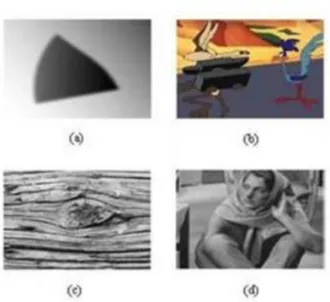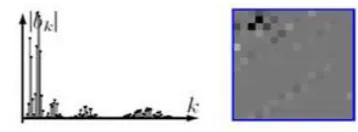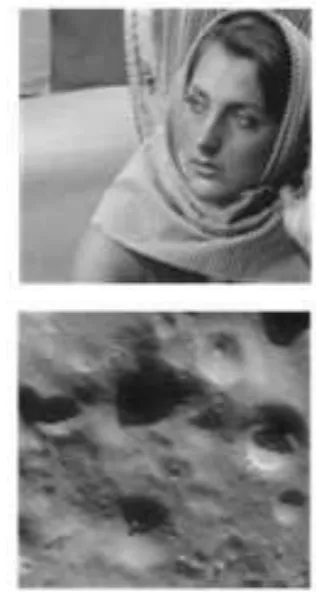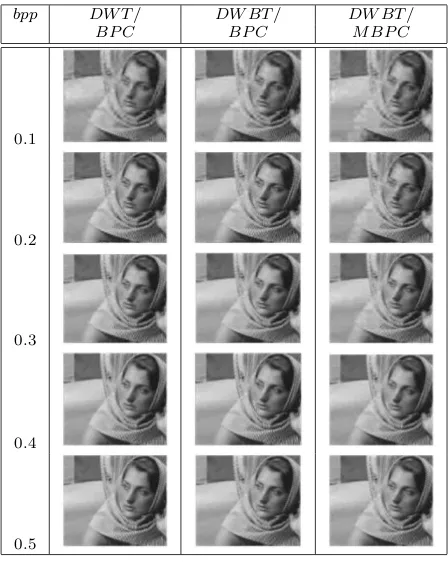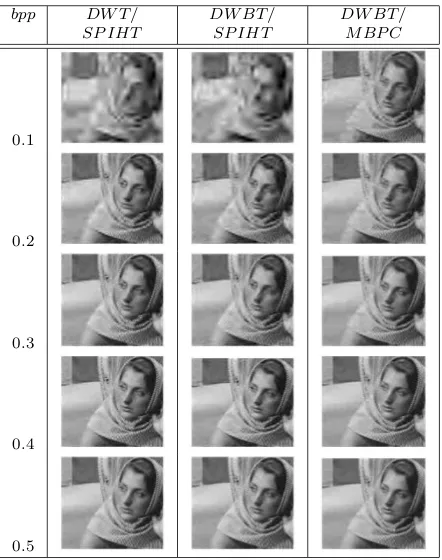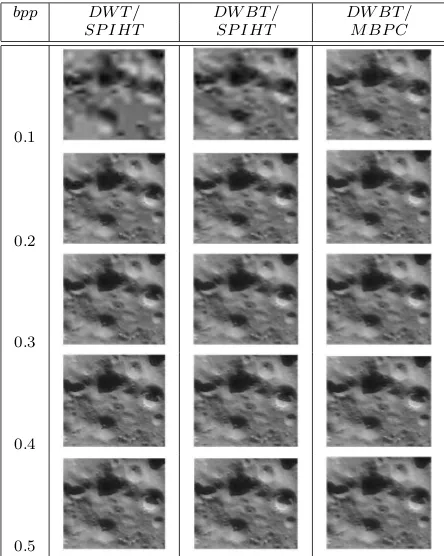Kumaraguru College of Technology, PSG College of Technology Coimbatore, Tamilnadu, India.
1avasuki@hotmail.com 2ptvani@yahoo.com
Abstract. Image compression has emerged as a major research area due to the phenomenal growth of applications that generate, process and transmit images. Image compression can be sequential or progressive. Progressive compression techniques generate an embedded bit stream and the fidelity of the reconstruction depends on the number of bits received and decoded. Natural images contain edges, geometry, texture and other discontinuities / details that are oriented in various directions. The state-of-the-art wavelet transform captures point singularities, but not along surfaces with geometric regularity. The second generation discrete wavelet-bandelet transform is proposed to overcome the drawback of wavelets in higher dimensions and capture the geometry in images. The redundancy in the wavelet transform is removed by bandeletization. The wavelet-bandelet coefficients are quantized and encoded using modified bit plane coding and the results have been compared with the existing bit plane coding and the set partitioning in hierarchical trees algorithm. Bandelets produce superior visual quality in the reconstructed image than wavelets. The parameters used for the evaluation of the algorithm are compression ratio, bits per pixel and peak signal-to-noise ratio.
Keywords: Image Compression, Progressive, Wavelets, Bandelets, Bit Plane Coding, SPIHT.
(Received March 15, 2010 / Accepted November 18, 2010)
1 Introduction
Bandelet transform is an orthogonal, multi-scale trans-form that captures the geometry in images. When there are edges in the image, there are sharp transitions across edges but along the edges there are regular variations, called geometric flow. The geometry of natural surfaces can be modeled as a function that isC2regular (Cis a constant) outside a set of edges that are also regular. In Figure 1 (a) - (d) shows some examples of images that are geometrically regular and also contain texture. Tak-ing advantage of geometrical structures in natural im-ages improves the efficiency of the compression, since the human perception is sensitive to curves and other geometric features.
Wavelet transform compresses the regular parts of
redun-Figure 1: Images with geometry and texture (a) Geometrically regu-lar image, (b) Cartoon, (c) Wood texture, (d) Barbara.
dancy in the discrete wavelet transform (DWT) is re-moved by bandeletization.
Figure 2: (a) Geometrically regular image (b) Triangular approxima-tion (c) Wavelet approximaapproxima-tion
In the existing literature [2], Le Pennec and Mallat have developed a double layer algorithm using wavelets and bandelets, and presented with examples. In [3] the same authors have produced a sparse image representa-tion using the geometric regularity of images and com-pared the performance of wavelet and bandelet coders. Wavelets introduce visible ringing effects, whereas ban-delets do not. In another paper [4], Le Pennec and Mallat have done a rigorous analysis of bandelet bases and presented mathematical proof that the bandelet ap-proximation satisfies an optimal asymptotic error decay rate. They have used quantized bandelet coefficients for coding edges and wavelets for coding smooth re-gions of the image. Peyre and Mallat have published several papers [6][7][8][9][10] on bandelets with basic concepts and rigorous mathematical analysis of the ban-delet transform and its application to image compres-sion and denoising. They have demonstrated the supe-riority of bandelets over wavelets in the visual quality of reconstructed images. They have also given an insight into the MATLAB implementation of bandelet
trans-form and the listing of the source code that is available in MATLAB Central. In [5] Liu et al have applied ban-delets and SPIHT for Synthetic Aperture Radar (SAR) image compression using a multi-layered image repre-sentation.
In this work, it is proposed to compress the coef-ficients of the DWBT using modified bit plane coding (MBPC) and the results have been compared with the existing bit plane coding (BPC) specified in JPEG2000 given in [13] and also with SPIHT as in [11]. It is found that the modified algorithm is superior in the re-constructed image quality compared to the other two algorithms. In this paper, the proposed algorithm has been evaluated using images for which this method is suitable. Section 2 gives an overview of the non-linear bandelets and the computation of the discrete wavelet-bandelet transform. Section 3 presents the proposed al-gorithm and Section 4 compares the results of the pro-posed algorithm with the existing algorithms. The pa-per concludes with Section 5.
2 Computation of Wavelet-Bandelet Transform
Bandelet bases are elongated in the direction of geo-metric flow, adapted for image geometry, with compact support. The human perception is sensitive to curves and other geometric features in the image and this is utilized in compression with bandelets. The geometry must be estimated from discrete image samples. The bandelet decomposition is computed with a geometric orthogonal transform that has basis functions elongated along the singularity, whereas the orthogonal wavelet transform has basis functions with a square support. The second generation bandelets apply bandeletization on subbands of the wavelet decomposition and removes the redundancy in the wavelet coefficients. The sub-bands of the wavelet decomposition are divided into dyadic squares. This is done by searching for a regu-larity flow in a direction along which the function is as regular as possible, as shown in Fig. 3.
To represent the image partition with few parame-ters and be able to compute an optimal partition with a fast algorithm, the image is partitioned into squares of varying dyadic sizes. The dyadic squares image seg-mentation is obtained by successive quadtree segmen-tation of square regions into four squares of half width on each wavelet scale. A square subdivided into four smaller squares corresponds to a node having four chil-dren in the quadtree. Fig. 4 gives an example of dyadic square image segmentation with the corresponding
direc-Figure 3: Geometric Flow in Dyadic Squares
Figure 4: Quadtree Segmentation
tion. The Lagrangian optimization function is defined with the approximation error and bit-rate required for encoding. The direction that minimizes the Lagrangian function produces the least approximation error and is the best direction for the given bit-rate. The bandelet transform is applied on each leaf of the quadtree in the specified best direction to produce the bandelet coef-ficients. This is the DWBT that removes the geomet-ric redundancy of orthogonal wavelet coefficients. The bandelet transform coding scheme has an error decay rate that is asymptotically optimal for geometrically reg-ular images. The 1D Haar transform applied on the wavelet coefficients in a specified direction is the warped Haar transform. This is the bandeletization that removes the correlation between wavelet coefficients near singu-larities (anisotropic redundancy). Fig. 5(a) shows the subband structure resulting from the 2D DWT applied on the input image. Fig. 5(b) shows the coefficients within the squareSalong the direction of geometry (di-rectional projection). The possible directions within the squareSare shown in Fig. 5(c).
Each sampling location of the regular grid is pro-jected orthogonal to the geometry direction to get a new point (Fig. 6(a)). The new points are ordered according to numbering along the perpendicular axis. The new 1D
Figure 5: (a) 2D DWT (b) Coefficients within square S along geom-etry (c) Possible directions within S
signal is shown in Fig. 6(b). The 1D wavelet transform is applied on the projected samples and the resulting coefficients are thresholded to produce a sparse repre-sentation, as shown in Fig. 7(a) and (b). The threshold determines the compression rate of the algorithm. The bandelet coefficients are quantized and encoded along with the dyadic segmentation and polynomial flow in-formation. For a fixed quantization step size, the best basis that minimizes the distortion-rate is found using Lagrangian optimization. The number of bits for cod-ing is the sum of the bits for representcod-ing the position and width of the square, bits for geometric flow and bits for the quantized bandelet coefficients. The segmenta-tion of the image supportRS,geometric flow in each region of the support RG and the quantized bandelet coefficientsRB are all encoded and contribute to the total bit-rateR. The number of bitsRS is equal to the number of nodes in the quadtree.RGis the sum of the bits in all the squares where a flow is defined.
Figure 6: (a) Projection of coefficients (b) Resulting 1D signal of projected coefficients
Figure 7: (a) 1D warped Haar transform coefficients (b) Bandelet coefficients
with a quantization stepT. The reconstructed imagefR is given by,
fR= �
v
QT(�f, bv�)bv (1)
wheref is the original image,bvis the bandelet ba-sis andR is the number of bits needed to specifyfR. QT is a uniform quantizer defined by,
QT(x) = qT, if �
q−1 2
�
T �x� �
q +1 2
� T (2)
The distortion of this coding scheme isDb(R) = �f − fR�2and for a given bit budgetRit is necessary to find the best bandelet basis that gives the lowest distortion.
3 Proposed Algorithm
This section presents the algorithm proposed in this work for progressive image compression with bandelets. It includes the following key steps:
(a) Discrete Wavelet Transform (b) Bandeletization
(c) Quantization (with modified step size) (d) Bit Plane Coding
The input image is transformed using the DWT for three levels of decomposition. The bandelet transform is applied on each subband, producing a sparser repre-sentation. This is the second generation wavelet-bandelets that acquires the texture information / geometry present in the image. Texture or geometry refers to patterns in the image that are oriented at various directions. As there are three levels of decomposition involved, three step sizes are allotted to the quantizer, one for each level. The quantizer step sizes based on the JPEG2000 standard is given below:
q(i, j) = sign[p(i, j)]�|p(i, j)| Δb + e�
(3)
Δb= bss × � 1
Gb
, Gb= 22×level (4)
wherep(i, j)is the input coefficient,q(i, j)is the quan-tized coefficient,bssis the base step size,Δbis the step size for subbandb,eis a constant andlevelis the level
of decomposition.
The third level, which contains the maximum (most important) information in the image, is allotted the small-est step size and it is progressively increased at the lower levels. This quantization makes the compression lossy, but the computational complexity of the coding process is significantly reduced and the compression achieved
is more. In the modified algorithm, the step size is cho-sen as constant for the subbands at all the levels. This improves the quality of the reconstructed image with DWBT as compared to the JPEG2000 standard. The parameters [1][12] used in the evaluation of the algo-rithm are: compression ratio (CR), bits per pixel (bpp) and peak signal-to-noise ratio (PSNR). CR is defined as the ratio of number of bits representing the image with-out compression to the number of bits representing the image with compression. bppis defined as the average number of bits used to represent each pixel in the image. PSNR is defined as the ratio of the square of the peak value of the image to the mean squared error, expressed in decibels (dB). Mean squared error is defined as the average value of the square of the difference between the original pixel values and the reconstruction values.
The original images that have been used for perfor-mance evaluation are given in Fig. 8(a) and (b). The results of encoding by applying DWT and DWBT with BPC specified in JPEG2000 standard and the proposed algorithm is compared in Table 1 and Table 2 for the images Barbara and Ridge on Eros respectively.
Figure 8: Original Test Images: (a) Barbara (b) Ridge on EROS
compres-Table 1: Comparison of the proposed algorithm results with DWT / BPC, DWBT / BPC, Barbara, PSNR(dB)
bpp DW T / DW BT / DW BT / BP C BP C M BP C 0.1 23.53 23.84 24.33 0.2 25.31 25.68 26.46 0.3 26.38 27.11 28.53 0.4 29.16 28.62 30.19 0.5 30.52 30.33 31.44 0.6 31.54 31.36 32.81 0.7 32.83 32.83 34.41 0.8 34.59 34.00 35.34 0.9 35.35 35.31 36.03 1.0 36.13 36.12 36.62
Table 2: Comparison of the proposed algorithm results with DWT / BPC, DWBT / BPC, Ridge on EROS, PSNR(dB)
bpp DW T / DW BT / DW BT / BP C BP C M BP C 0.1 30.32 30.77 31.05 0.2 33.49 33.70 34.34 0.3 35.68 35.78 36.75 0.4 37.62 37.51 38.18 0.5 39.13 39.08 39.39 0.6 40.24 40.00 40.98 0.7 41.22 41.15 42.12 0.8 42.20 42.21 42.54 0.9 43.28 43.36 42.54 1.0 44.15 44.35 42.54
sion algorithms are compared in Table 3 and Table 4. The improvement in PSNR of second generation
bandelets over wavelets is evident from the results tabulated. The DWBT with BPC produces PSNR that is higher by 0.1 to 0.5 dB than DWT with BPC. The improvement produced depends on the bit-rate and the test image. At some of the bit-rates, the DWBT / BPC algorithm produces smaller PSNR than the DWT / BPC algorithm. But the bandelets are superior in acquiring the texture information in images, as shown in the vi-sual reconstructions tabulated. The results of progres-sive compression with the modified algorithm validates the superiority of bandelets over wavelets. The recon-structed images for the above algorithm also demon-strate the efficiency of bandelets in acquiring the texture information in the image as compared to wavelets. The modified algorithm with DWBT increases the PSNR of the reconstructed images in the range of 0.5 to 1.5 dB. This is validated by the quality of the reconstructions. The CR attained by the three algorithms for the two test images are given in Table 5. The results tabulated below show the higher compression capability of the proposed algorithm with bandelets. For both the test images, CR is highest for the proposed algorithm compared to DWT or DWBT with BPC. The results validate the suitability of bandelets for compressing images with texture /
ge-Table 3: Comparison of reconstructed images with DWT / BPC, DWBT / BPC and DWBT / MBPC, bior4.4 wavelet, Barbara, PSNR(dB)
bpp DW T / DW BT / DW BT / BP C BP C M BP C
0.1
0.2
0.3
0.4
0.5
ometry.
4 Comparison of Proposed Algorithm with SPIHT
The SPIHT algorithm has been applied on the wavelet-bandelet coefficients to obtain a progressive reconstruc-tion of the input image and it has been compared with the reconstruction using wavelets. Since the bandelet transform is applied on every subband of the wavelet decomposition, the tree structure of wavelets is preserved in the second generation bandelets also. So the SPIHT algorithm will be suitable for compressing the coeffi-cients produced. The geometry in the image will be re-flected in all the subbands at the same spatial location. The results of applying SPIHT on DWT coefficients has been compared with DWBT in Table 6 and Table 7 and the corresponding reconstructed images are presented in Table 8 and Table 9.
Table 4: Comparison of reconstructed images with DWT / BPC, DWBT / BPC and DWBT / MBPC, bior4.4 wavelet, Ridge on EROS, PSNR(dB)
bpp DW T / DW BT / DW BT / BP C BP C M BP C
0.1
0.2
0.3
0.4
0.5
Table 5: Comparison of CR for DWT / BPC, DWBT / BPC, DWBT / MBPC
Image DW T / DW BT / DW BT / BP C BP C M BP C Barbara 4.23 4.13 4.94 Ridgeon 6.93 6.67 8.96
EROS
Table 6: Comparison of DWT / SPIHT with DWBT / SPIHT and DWBT / MBPC, Barbara, PSNR(dB)
bpp DW T / DW BT / DW BT / SP IHT SP IHT M BP C 0.1 20.59 20.72 24.33 0.2 24.02 24.06 26.46 0.3 26.42 26.71 28.53 0.4 28.30 28.47 30.19 0.5 30.67 30.45 31.44 0.6 32.14 31.99 32.81 0.7 33.38 33.16 34.41 0.8 34.67 34.40 35.34 0.9 35.72 35.61 36.03 1.0 36.63 36.55 36.62
algorithm. At higher bit-rates, DWT gives a higher PSNR than DWBT. Comparing SPIHT and the modi-fied bit plane coding with DWBT it is found that for most of the images, the modified algorithm is superior
Table 7: Comparison of DWT / SPIHT with DWBT / SPIHT and DWBT / MBPC, Ridge on EROS, PSNR(dB)
bpp DW T / DW BT / DW BT / SP IHT SP IHT M BP C 0.1 24.10 26.48 31.05 0.2 31.06 31.92 34.34 0.3 34.33 34.76 36.75 0.4 36.44 36.74 38.18 0.5 38.17 38.38 39.39 0.6 39.40 39.59 40.98 0.7 40.45 40.73 42.12 0.8 41.48 41.78 42.54 0.9 42.29 42.55 42.54 1.0 43.07 43.34 42.54
Table 8: Reconstructed Images for DWT / SPIHT with DWBT / SPIHT and DWBT / MBPC, bior4.4 wavelet, Barbara, PSNR(dB)
bpp DW T / DW BT / DW BT / SP IHT SP IHT M BP C
0.1
0.2
0.3
0.4
0.5
to SPIHT. Therefore, for a given bit-rate and PSNR, modified BPC produces higher compression than SPIHT. The visual quality of the reproduced images also corre-late with the PSNR values obtained.
Table 9: Reconstructed Images for DWT / SPIHT with DWBT / SPIHT and DWBT/MBPC, bior4.4 wavelet, Ridge on EROS, PSNR(dB)
bpp DW T / DW BT / DW BT / SP IHT SP IHT M BP C
0.1
0.2
0.3
0.4
0.5
have to be encoded in a lossless manner. Since the ge-ometry varies from image to image, the number of over-head bits are also variable. The bits required for cod-ing quadtree decomposition and direction information is only a fraction of that required for coding the quan-tized DWBT coefficients comparatively.
5 Conclusion
The results of applying DWT and DWBT compressed with BPC, SPIHT and the proposed MBPC algorithm on two test images have been compared. It is found that the second generation DWBT acquires the texture in-formation in the images better than DWT. The DWBT coefficients are quantized and encoded using the pro-posed MBPC and the results are found to be superior to the bit plane coding algorithm as well as SPIHT. The PSNR values are higher for DWBT-MBPC as also the visual quality of reconstruction compared to DWT-BPC, DWBT-BPC and DWBT-SPIHT. The quadtree de-composition and the direction information have to be encoded in a lossless manner and transmitted along with the compressed coefficients. This additional overhead
in bits is not required in wavelets and it is one of the dis-advantages of the bandelet transform. It is compensated by the superior visual quality of images with textures / geometry. Wavelets introduce visible ringing effects whereas they are concealed in bandelets.
[1] Gonzalez, R. C. and Woods, R. E. Digital Image Processing, Pearson Education Asia, New Delhi, Sec-ond Edition, 2002.
[2] Le Pennec, E. and Mallat, S. Image Compression with Geometric Wavelets, Proceedings of IEEE Inter-national Conference on Image Processing, Vancouver, BC, Canada, p.661-664, 2000.
[3] Le Pennec E. and Mallat S. Bandelet Image Ap-proximation and Compression, SIAM Journal of Mul-tiscale Modeling and Simulation, v.4(3), p.992-1039, 2005.
[4] Le Pennec E. and Mallat S. Sparse Geometrical Image Representation with Bandelets, IEEE Transac-tions on Image Processing, v.14(4), p.423- 438, 2005.
[5] Liu H., Hou B., Wang S. and Jiao L. SAR Image Compression using Bandelets and SPIHT, Proceedings of IEEE International Conference on Radar, Beijing, China, p.1-4, 2006.
[6] Peyre G. and Mallat S. Surface Compression with Geometric Bandelets, ACM Transactions on Graphics, v.14(3, p.601-608, 2005.
[7] Peyre G. and Mallat S. Discrete Bandelets With Geometric Orthogonal Filters, Proceedings of IEEE In-ternational Conference on Image Processing, Genoa, Italy, p.I-65-I-68, 2005.
[8] Peyre G. and Mallat S. A Matlab Tour of Second Generation Bandelets, 2005. www.ceremade.dauphine.fr/ peyre/bandelets/BandeletsTutorial.pdf.
[9] Peyre G. and Mallat S. A Review of Bandelet Methods for Geometrical Image Representation, Nu-merical Algorithms, v.44(3), p.205-234, 2007.
[10] Peyre G. and Mallat S. Orthogonal Bandelet Bases for Geometric Images Approximation, Commu-nications on Pure and Applied Mathematics, v.61(9), p.1173-1212, 2008.
[11] Said A. and Pearlman W.A. A New, Fast and Efficient Image Codec Based on Set Partitioning in Hi-erarchical Trees, IEEE Transactions on Circuits and Sys-tems for Video Technology, v.6(3), p.243-250, 1996.
[12] Sayood K. Introduction to Data Compression, Morgan Kaufmann Publishers Inc., 2nd Edition, New Delhi, 2000.
